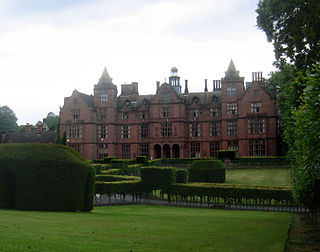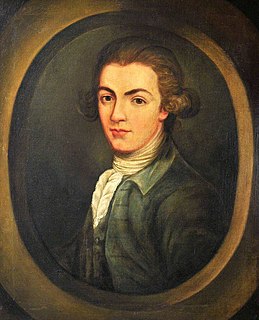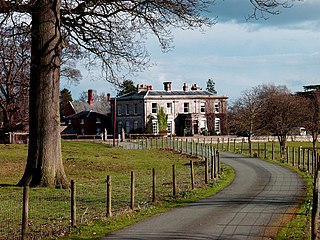
Earl of Powis (Powys) is a title that has been created three times. The first creation came in the Peerage of England in 1674 in favour of William Herbert, 3rd Baron Powis, a descendant of William Herbert, 1st Earl of Pembroke. In 1687, he was further honoured when he was made Marquess of Powis.

Earl of Plymouth is a title that has been created three times: twice in the Peerage of England and once in the Peerage of the United Kingdom.

Powis Castle is a medieval castle, fortress and grand country house near Welshpool, in Powys, Wales. The seat of the Herbert family, Earls of Powis, the castle is known for its formal gardens and for its interiors, the former having been described as "the most important", and the latter "the most magnificent", in Wales. The castle and garden are under the care of the National Trust. Powis Castle is a Grade I listed building.

Weston Park is a country house in Weston-under-Lizard, Staffordshire, England, set in more than 1,000 acres (400 ha) of park landscaped by Capability Brown. The park is located 10 miles (16 km) north-west of Wolverhampton, and 8 miles (13 km) north-east of Telford, close to the border with Shropshire. The 17th-century Hall is a Grade I listed building and several other features of the estate, such as the Orangery and the Stable block, are separately listed as Grade II.

Hewell Grange is a former country house in Tardebigge, Worcestershire, England. "One of the most important late 19th century country houses in England", the mansion was built between 1884 and 1891 by George Frederick Bodley and Thomas Garner for Robert Windsor-Clive, later first Earl of Plymouth. Constructed in the Jacobethan style, it was "perhaps the last Victorian prodigy house". After the Second World War, the third earl sold the Hewell estate to the Crown and it was redeveloped as a prison. The mansion was used to house young offenders, and later low-risk prisoners, while adult prisons were built in the grounds. The site was subsequently consolidated as HM Prison Hewell. In 2019, the Ministry of Justice announced the closure of the Category D open prison housed in Hewell Grange, after a highly critical report by Her Majesty's Inspectorate of Prisons.

Other Archer Windsor, 6th Earl of Plymouth was an English nobleman, the eldest and only surviving son of the 5th Earl of Plymouth by his wife and cousin, Hon. Sarah Archer, daughter and eventual co-heiress of the 2nd Baron Archer. He was the sixth Earl of Plymouth of the 1682 creation.

Ivor Miles Windsor-Clive, 2nd Earl of Plymouth PC was an English nobleman and Conservative Party politician.
The Honourable Robert Windsor-Clive was a British Conservative Party politician.
The Hon. Robert Henry Clive was a British Conservative Party politician.

Edward Clive, 1st Earl of Powis,, known as the Lord Clive between 1774 and 1804, was a British politician who sat in the House of Commons from 1774 to 1794 when he was raised to the peerage as Baron Clive.

Henry Arthur Herbert, 1st Earl of Powis PC, known as Henry Herbert until 1743 and as The Lord Herbert of Chirbury between 1743 and 1748, was a British peer and politician.

St Mary the Virgin's Church is a former priory church located in the village of Bromfield, Shropshire, England. It is an active Anglican parish church in the deanery of Ludlow, the archdeaconry of Ludlow, and the diocese of Hereford. Its benefice is united with those of 5 other parishes to form the Bromfield Benefice. The church is recorded in the National Heritage List for England as a designated Grade I listed building.

John Hiram Haycock (1759-1830) was an architect who built many notable buildings in Shropshire and Montgomeryshire. He was the son of William Haycock (1725-1802), a carpenter and joiner of Shrewsbury. He was apprenticed to his father and became a freeman of the Shrewsbury Carpenters’ and Bricklayers’ Company in 1796. From about 1814 he worked in partnership with his son Edward Haycock, Sr., and became the Shropshire county surveyor in 1824.
Bromfield is a civil parish in Shropshire, England. It contains 44 listed buildings that are recorded in the National Heritage List for England. Of these, one is listed at Grade I, the highest of the three grades, two are at Grade II*, the middle grade, and the others are at Grade II, the lowest grade. The parish contains the village of Bromfield and the surrounding countryside. Two buildings have retained material from the 12th century, the gatehouse of Bromfield Priory, and St Mary the Virgin's Church. In the parish is a country house, Oakly Park; this and associated structures are listed. Most of the other listed buildings are houses, cottages, farmhouses and farm buildings. Others include a public house, a former corn mill, a former sawmill, a bridge, a weir, and a war memorial.
Burford is a civil parish in Shropshire, England. It contains 13 listed buildings that are recorded in the National Heritage List for England. Of these, one is listed at Grade I, the highest of the three grades, two are at Grade II*, the middle grade, and the others are at Grade II, the lowest grade. The parish contains the village of Burford and the surrounding countryside. Some of the listed buildings are grouped around Burford House and its neighbouring St Mary's Church to the southwest of the village. Otherwise, in and around the village, the listed buildings include a bridge over the River Teme, a hotel, a hospital, a cottage, a former toll house, and two mileposts.
Clive is a civil parish in Shropshire, England. It contains 14 listed buildings that are recorded in the National Heritage List for England. Of these, one is listed at Grade II*, the middle of the three grades, and the others are at Grade II, the lowest grade. The parish contains the village of Clive and the surrounding countryside. The listed buildings consist of a church with a memorial in the churchyard, houses, cottages and farmhouses with associated structures, and a boundary stone.
Craven Arms is a civil parish in Shropshire, England. It contains 23 listed buildings that are recorded in the National Heritage List for England. Of these, two are listed at Grade I, the highest of the three grades, and the others are at Grade II, the lowest grade. The parish contains the small town of Craven Arms, the hamlets of Halford and Stokesay, and the surrounding countryside.
Richard's Castle (Shropshire) is a civil parish in Shropshire, England. It contains 30 listed buildings that are recorded in the National Heritage List for England. Of these, one is listed at Grade I, the highest of the three grades, two are at Grade II*, the middle grade, and the others are at Grade II, the lowest grade. The parish lies to the northeast of the village of Richard's Castle. It contains the villages of Overton and Woofferton and smaller settlements, and is otherwise rural. Most of the listed buildings in the parish are houses, cottages, farmhouses and farm buildings, the earliest of which are timber framed. There are two country houses that are listed, together with associated structures. The other listed buildings include a public house, an aqueduct, a bridge, a former toll house, two mileposts, and a church.
Weston-under-Redcastle is a civil parish in Shropshire, England. It contains 24 listed buildings that are recorded in the National Heritage List for England. Of these, one is listed at Grade I, the highest of the three grades, two are at Grade II*, the middle grade, and the others are at Grade II, the lowest grade. The parish includes the village of Weston-under-Redcastle and the surrounding area. The area contains Hawkstone Park within which are a number of listed buildings. Many of the listed buildings elsewhere are houses, cottages and farmhouses, the earliest of which are timber framed. The other listed buildings include a ruined castle, a church, village stocks and a pump, and a former dower house and associated structures

Mamhead House, Mamhead, Devon, is a country house dating from 1827. Its origins are older but the present building was constructed for Robert William Newman, an Exeter merchant, in 1827–1833 by Anthony Salvin. The house is Grade I listed. The parkland has its own Grade II* listing. It was for a time known as Dawlish College.












